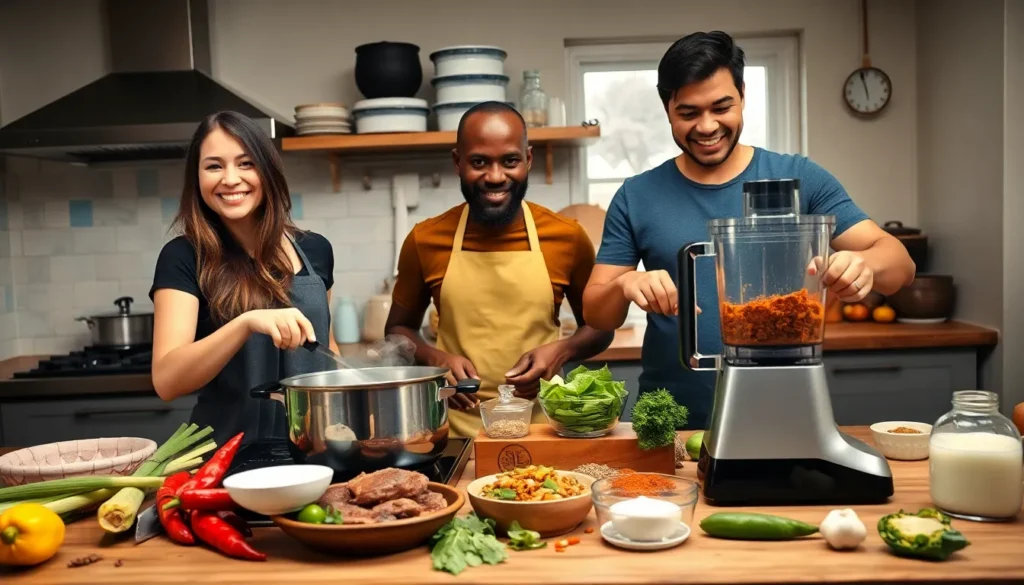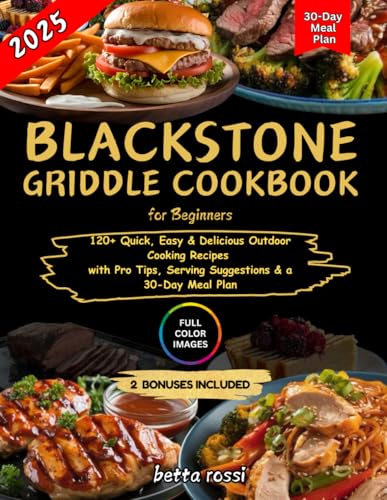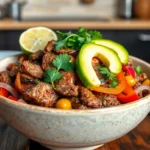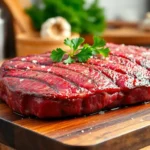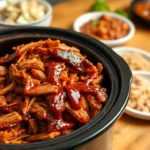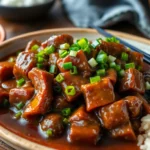We’re about to take you on a culinary journey to Malaysia with one of Southeast Asia’s most beloved dishes – beef rendang. This rich and aromatic curry isn’t just a meal; it’s a masterpiece that transforms tough cuts of beef into melt-in-your-mouth perfection through hours of slow cooking with coconut milk and an incredible blend of spices.
What makes Malaysian beef rendang truly special is its complex flavor profile that balances sweet, spicy, and savory notes in perfect harmony. The dish originates from the Minangkabau people of West Sumatra but has become deeply rooted in Malaysian cuisine, earning its place as one of the industry’s most delicious foods according to CNN’s international food poll.
We’ll show you how to create this restaurant-quality dish in your own kitchen using authentic ingredients and traditional techniques. Get ready to fill your home with the most incredible aromas as we guide you through making authentic Malaysian beef rendang that’ll have your family asking for seconds.
Equipment Needed
Creating authentic Malaysian beef rendang requires the right tools to achieve that perfect balance of flavors and textures. We recommend gathering these essential pieces of equipment before starting your cooking journey.
Heavy-bottomed pot or Dutch oven serves as the foundation for successful rendang preparation. This cookware distributes heat evenly and prevents the coconut milk from scorching during the long cooking process. We prefer using a 4-quart capacity pot for optimal results.
Food processor or high-powered blender transforms fresh aromatics into a smooth paste. Your rendang’s flavor depth depends on properly grinding lemongrass, galangal, shallots, and chilies into a fine consistency. A mortar and pestle works as an authentic alternative if you prefer traditional methods.
Wooden spoon or heat-resistant spatula becomes your best friend during the stirring process. These tools won’t scratch your pot’s surface and withstand the continuous mixing required as the rendang reduces. We recommend having two spoons available for easier handling.
Fine-mesh strainer helps achieve silky smooth coconut milk if you’re using fresh coconuts. This step removes any remaining coconut flesh particles that could affect the final texture. Store-bought coconut milk users can skip this equipment.
Sharp chef’s knife ensures clean cuts through tough beef cuts and precise chopping of aromatics. Your knife should handle dense root vegetables like galangal and fresh turmeric without dulling quickly. We suggest sharpening your blade before starting.
Cutting board provides a stable surface for all your prep work. Choose a large board that accommodates multiple ingredients without overcrowding. Separate boards for meat and vegetables maintain food safety standards.
Measuring cups and spoons guarantee consistent results every time you make rendang. Precise measurements of coconut milk, palm sugar, and tamarind paste directly impact your dish’s authentic taste profile.
Ingredients
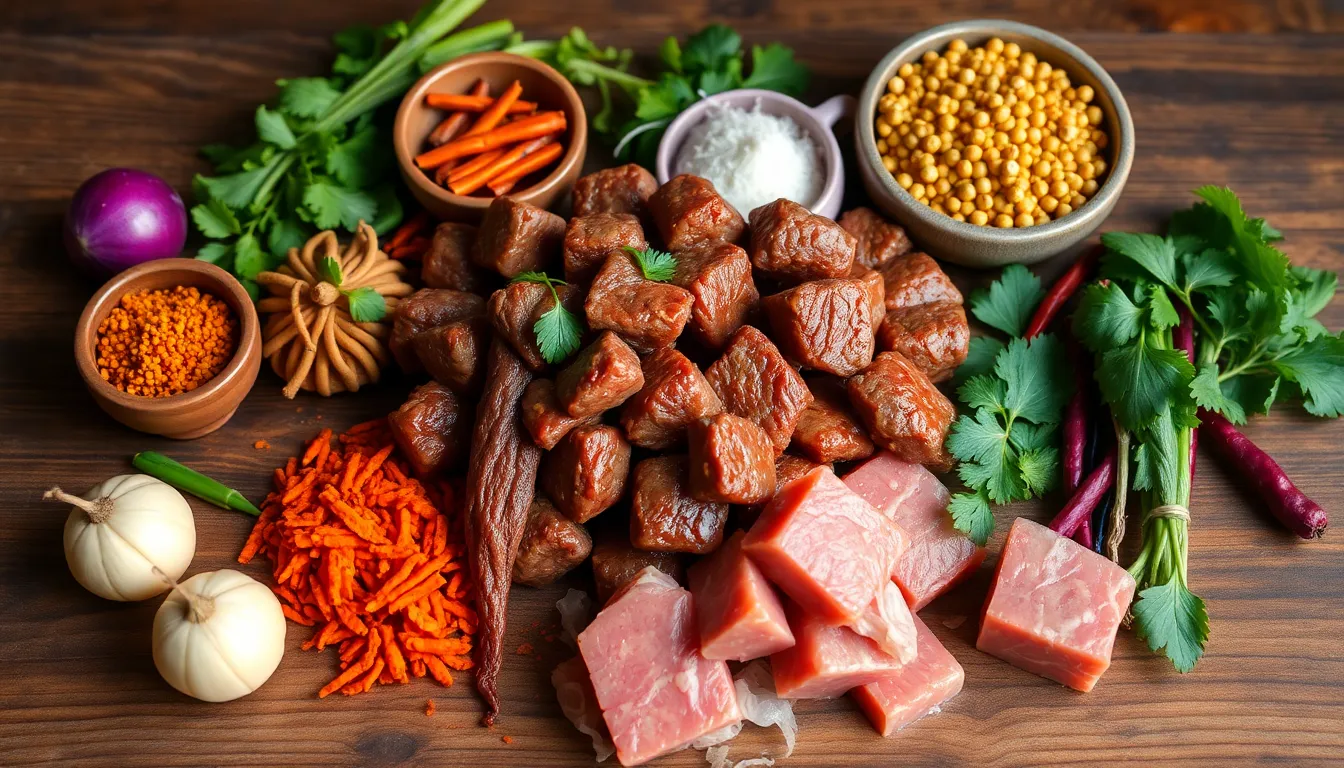
Gathering the right ingredients forms the foundation of authentic Malaysian beef rendang. We’ll organize these components into three categories to streamline your preparation process.
For the Spice Paste
The aromatic spice paste serves as the flavor base for our rendang:
- 5 shallots
- 5 cloves garlic
- 1 inch galangal
- 1 inch ginger
- 3 stalks lemongrass (white part only)
- 10-30 dried red chilies (soaked in warm water and seeded)
- ½ tsp ground turmeric
- 1 tbsp ground coriander
For the Beef and Coconut
These core ingredients create the rich protein and creamy base:
- 1 to 1.5 lbs boneless beef (short ribs or stewing cuts), cut into cubes
- 400 ml to 1 cup thick coconut milk or coconut cream
- 1 cup water
- 1-2 tsp salt (to taste)
- 1 tbsp sugar or palm sugar (to taste)
- 2 tsp tamarind pulp (soaked in warm water, seeds discarded)
Additional Aromatics
- 1 stalk lemongrass, bruised
- 6 kaffir lime leaves, finely sliced (or 2 large turmeric leaves as alternative)
- 1 stick of cinnamon (about 2-inch length)
- 3 cloves
- 3 star anise
- 3 cardamom pods
- 4 tbsp kerisik (toasted grated or desiccated coconut)
Prep Work
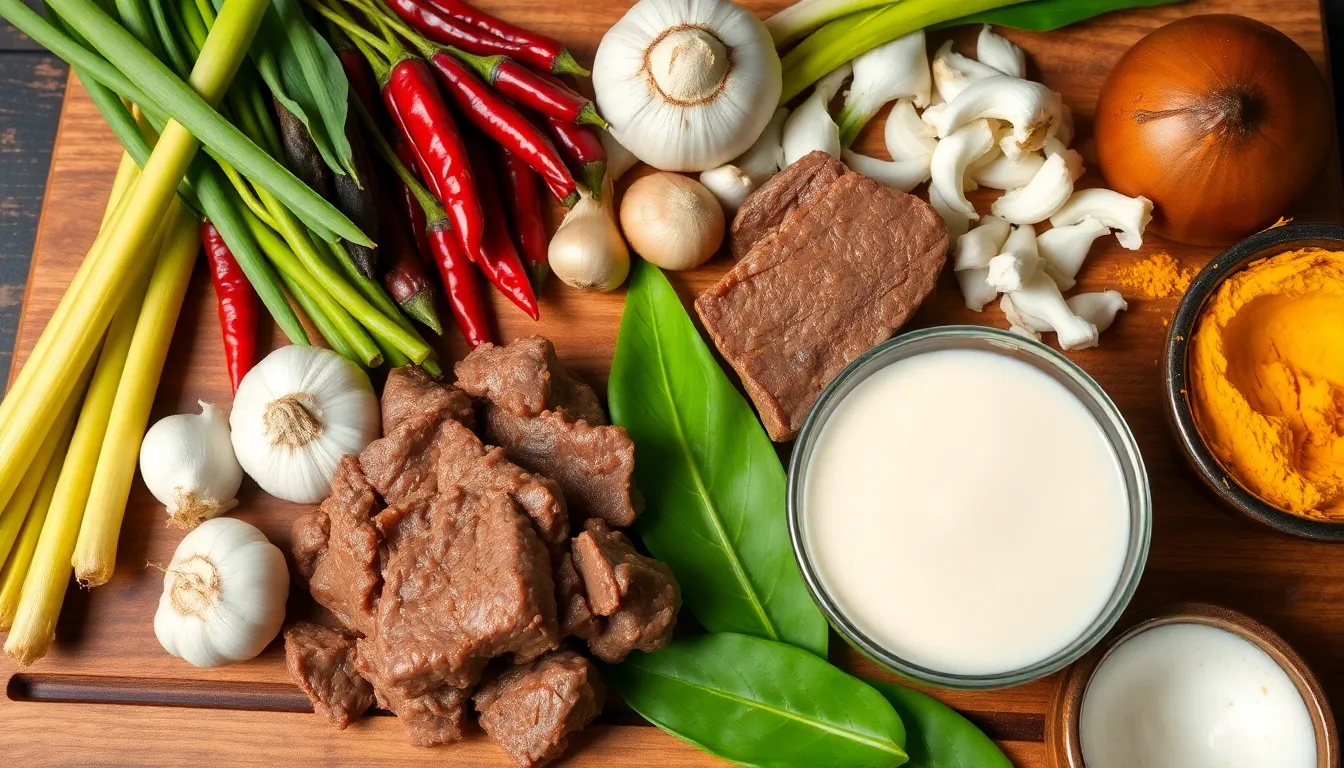
Before we begin cooking our Malaysian beef rendang, proper preparation sets the foundation for achieving that authentic restaurant-quality flavor. We’ll organize our ingredients and complete essential prep steps to ensure smooth cooking throughout the process.
Preparing the Spice Paste
We start by soaking 20-30 dried red chilies in boiling water for about 30 minutes until they soften completely. Once softened, we drain the chilies and remove the seeds to control the heat level of our rendang.
Next, we gather our aromatics for the spice paste. We need 3 stalks of lemongrass, using only the white parts, along with 2.5 cm of fresh galangal and 5 cm of fresh ginger. We also prepare 5 cloves of garlic and quarter 2 large onions for easier blending.
Using a food processor or mortar and pestle, we blend the soaked chilies with the prepared aromatics, adding ½ teaspoon ground turmeric and 1 tablespoon ground coriander. We process everything into a fine paste, adding small amounts of water as needed to achieve the right consistency. The paste should be smooth and well combined without any large chunks remaining.
Preparing the Beef
We select 1 kg of braising or stewing beef, which works best for the long cooking process required in rendang. These cuts contain enough connective tissue to become tender and flavorful during slow cooking.
We cut the beef into generous chunks, ensuring each piece is substantial enough to hold its shape throughout the cooking process. The pieces should be roughly 2-3 inches in size for optimal results.
While preparing the beef, we also ready our aromatic ingredients. We prepare 2 large turmeric leaves or about 6 kaffir lime leaves, which will infuse our rendang with authentic Malaysian flavor. We also measure out 400 ml of coconut milk, gather our whole spices including cinnamon stick, star anise, cloves, and cardamom pods, and prepare 4 tablespoons of kerisik (toasted grated coconut) for adding richness later in the cooking process.
Instructions
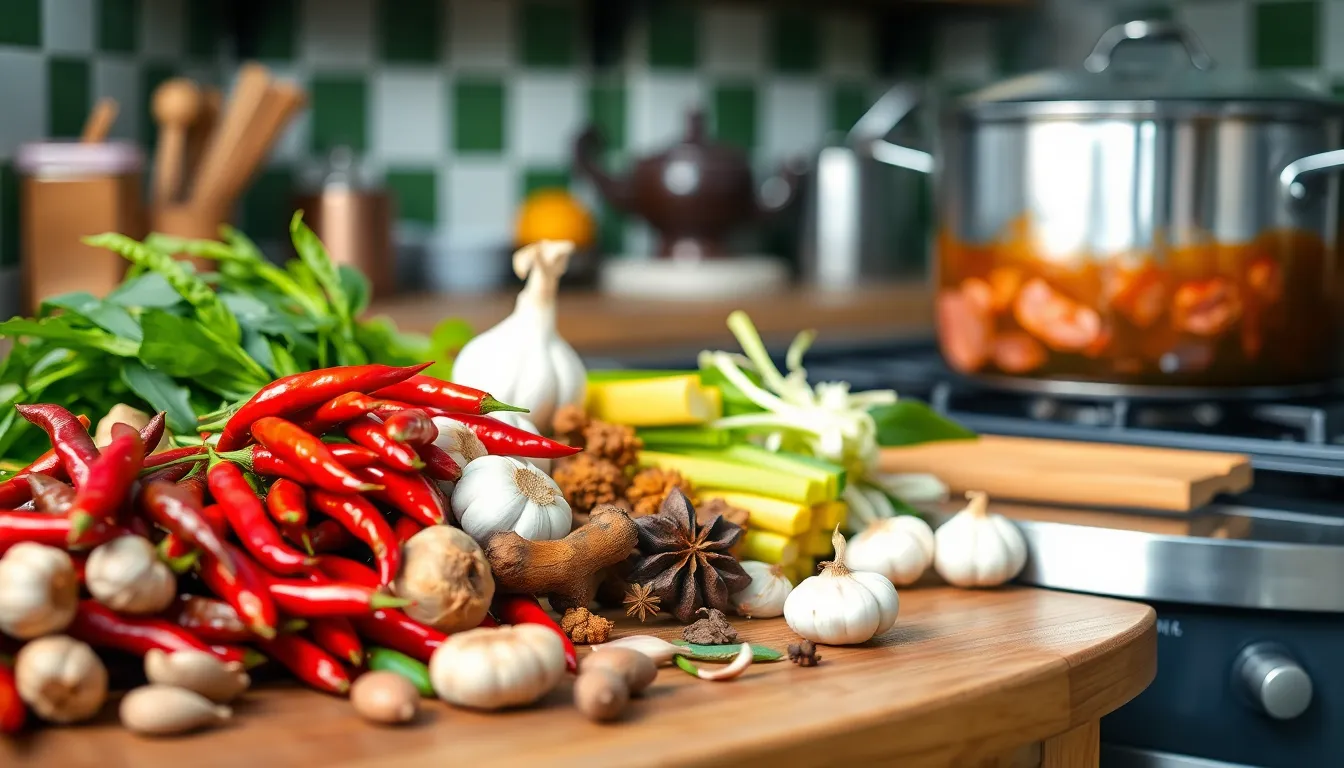
Now that we have all our ingredients prepped and ready, let’s walk through the step-by-step process to create this authentic Malaysian beef rendang. We’ll build layers of flavor through careful cooking techniques that transform simple ingredients into an extraordinary dish.
Making the Rendang Paste
We start by creating the essential spice base that gives rendang its distinctive flavor profile. Remove the seeds from our soaked dried red chilies and drain them thoroughly. Add the softened chilies to a food processor along with the white parts of lemongrass, galangal, ginger, garlic, and shallots. Sprinkle in the ground turmeric and ground coriander for additional depth.
Blend the mixture into a fine paste, adding a splash of water if needed to help the blending process. The paste should be smooth and well-combined without any large chunks remaining. This aromatic foundation will infuse our beef with complex flavors during the cooking process.
Cooking the Beef
Heat oil in our heavy-bottomed pot over medium heat and add the whole spices including cinnamon stick, star anise, cloves, and cardamom pods. Toast these spices for about 30 seconds until fragrant, then add the bruised lemongrass stalks to the pot.
Add our prepared rendang paste to the aromatic oil and cook for 10-15 minutes, stirring frequently to prevent burning. The paste will thicken and lose its raw smell as it cooks, developing a rich reddish-brown color. Add the beef cubes to the pot and coat them thoroughly with the paste, allowing the meat to sear slightly. Stir in the kaffir lime leaves for an additional layer of citrusy aroma.
Slow Cooking Process
Pour the thick coconut milk into the pot along with enough water to just cover the beef. Add salt, coconut sugar, and tamarind juice to balance the flavors with sweet and tangy notes. Bring the mixture to a gentle simmer, then cover the pot with a lid.
Maintain a low simmer for approximately 1 hour, stirring occasionally to prevent sticking. The beef should become tender during this time while the sauce begins to thicken and reduce. The slow cooking process allows the meat to absorb all the complex spice flavors while maintaining its texture.
Final Reduction
Remove the lid from the pot and continue cooking for another 30-40 minutes over medium-low heat. Stir the rendang frequently but gently to prevent the sauce from sticking to the bottom of the pot. The coconut milk will begin to separate and oil will rise to the surface as the sauce reduces.
Watch carefully as the sauce transforms into a rich, dark brown coating that clings to the tender beef. The rendang is ready when the meat is fork-tender and the sauce has achieved a dry curry consistency. If the sauce reduces too quickly, temporarily remove the beef and finish reducing the sauce before returning the meat to the pot for serving.
Cooking Tips for Perfect Malaysian Beef Rendang
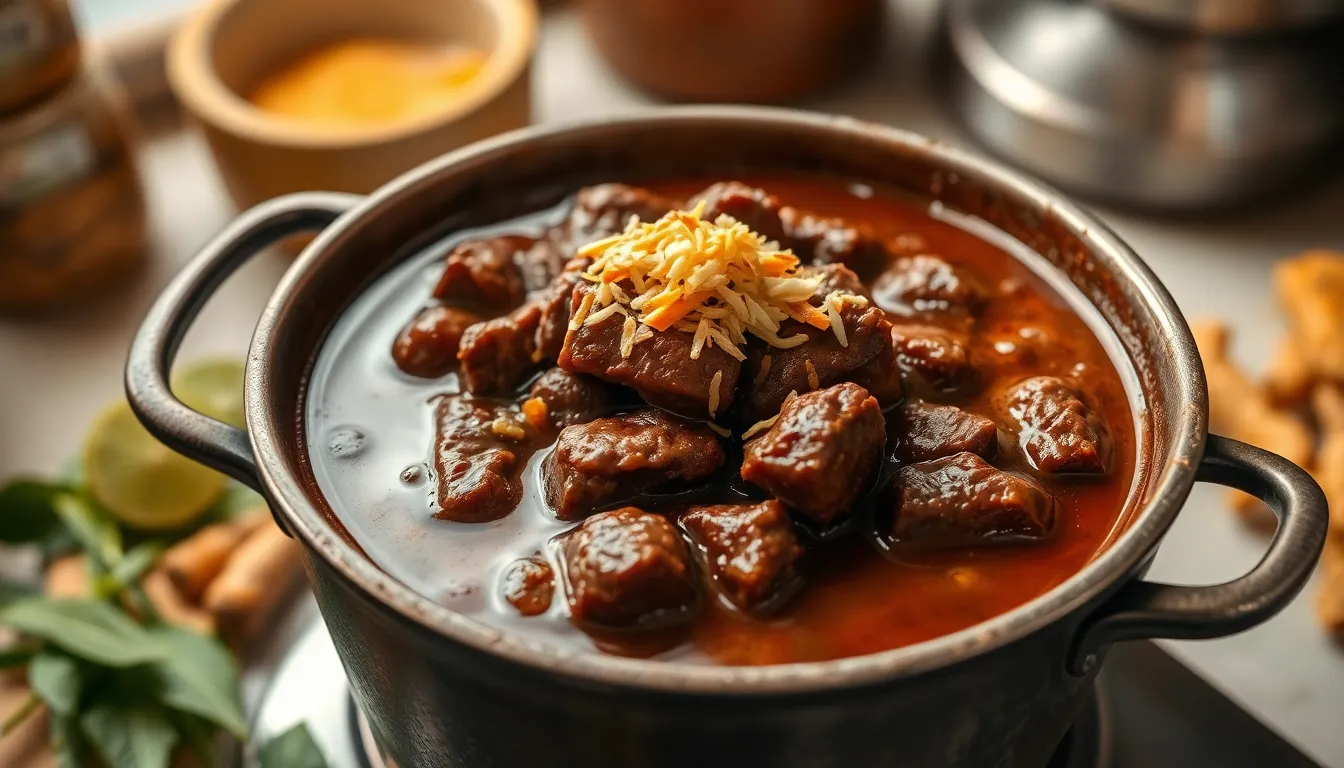
Achieving the perfect beef rendang requires patience and attention to exact cooking techniques that transform this dish from good to extraordinary. We’ve gathered essential tips to help you master this beloved Malaysian curry.
Embrace Slow Cooking on Low Heat
Low and slow cooking remains the cornerstone of authentic beef rendang. We recommend maintaining gentle heat throughout the cooking process to ensure the beef becomes ultra tender while allowing deep flavor infusion. Traditional cooks use charcoal with clay pots, but we can achieve excellent results using a heavy-bottomed pot or slow cooker on low settings. The extended cooking time of several hours allows tough beef cuts to break down completely while the sauce reduces to its characteristic thick coating.
Master the Art of Kerisik
Kerisik (toasted grated coconut) adds the distinctive nutty aroma and creamy texture that sets Malaysian beef rendang apart from other curries. We suggest toasting fresh grated coconut until golden brown, then pounding it traditionally with a mortar and pestle to release the coconut oils fully. This technique creates the authentic flavor profile that makes beef rendang so memorable.
Monitor the Sauce Reduction Carefully
Stirring frequency becomes crucial during the final cooking stages as the sauce thickens dramatically. We recommend stirring more frequently toward the end to prevent burning while the liquid reduces. The sauce should coat the beef pieces completely, creating an almost dry consistency that clings to each piece.
Watch for Visual Cues
Oil separation and darkening near the end of cooking signal that your rendang has reached perfection. We look for the rich brown color that develops when the sauce reduces completely and oil begins to separate from the mixture. This visual cue indicates that the flavors have concentrated and intensified to their fullest potential.
Use Fresh Aromatics
Fresh herbs like turmeric leaves or kaffir lime leaves impart the authentic fragrance that distinguishes restaurant-quality rendang. We add these leaves during the slow cooking process to infuse their essential oils throughout the dish. The aromatic compounds release gradually, creating layers of flavor that develop over time.
Prevent Sticking with Proper Technique
Constant stirring during the paste cooking stage prevents burning and ensures even flavor development. We cook the rendang paste for 10-15 minutes until it becomes thick and fragrant, stirring continuously to avoid sticking to the pot bottom. This foundation step determines the overall flavor quality of the finished dish.
Storage and Reheating Instructions
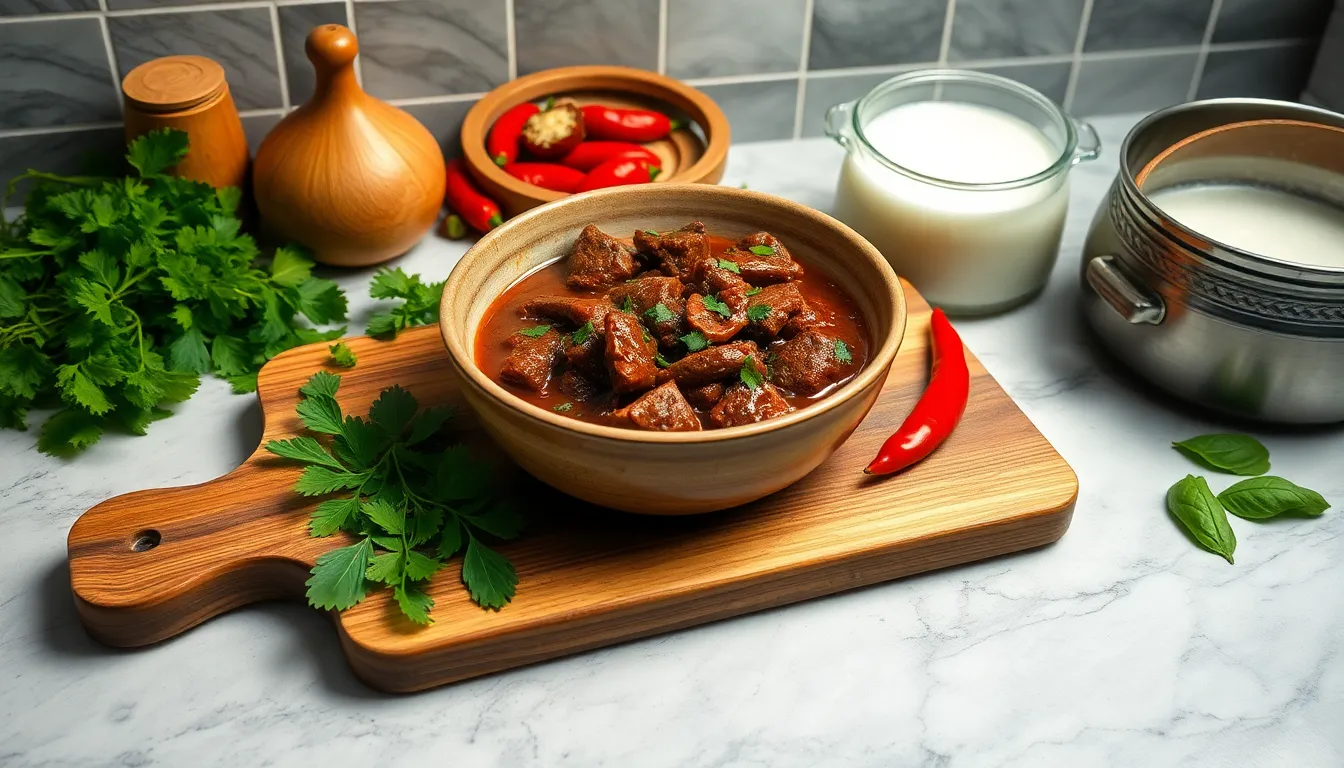
Our perfectly crafted beef rendang becomes even more flavorful after resting, making proper storage techniques essential for maintaining its authentic taste and texture. We recommend allowing the rendang to cool completely at room temperature before transferring it to storage containers.
Refrigerator Storage
Fresh beef rendang stays delicious in the refrigerator for up to 4 days when stored properly. We transfer our cooled rendang into airtight containers to prevent moisture loss and flavor contamination. Glass containers work exceptionally well for maintaining the rich coconut milk base and preventing any metallic taste transfer.
The thick sauce acts as a natural preservative, helping maintain the beef’s tender texture throughout the storage period. We often find that refrigerated rendang tastes even better the following day as the complex spice blend continues to meld together.
Freezer Storage
Long term storage becomes simple when we freeze our beef rendang in freezer-safe containers or heavy-duty ziplock bags. Properly frozen rendang maintains its quality for up to 2 months without important flavor degradation.
We portion the rendang into meal-sized containers before freezing to avoid repeated thawing and refreezing cycles. This method preserves the integrity of both the tender beef and the rich coconut sauce.
Proper Reheating Techniques
Thawing frozen rendang requires patience for optimal results. We move frozen portions to the refrigerator overnight, allowing gradual thawing that maintains the sauce consistency and meat texture.
Stovetop reheating provides the best results for preserving authentic flavors. We reheat our rendang gently over low heat, stirring frequently to prevent sticking or burning. Adding a splash of water or fresh coconut milk helps restore the proper sauce consistency if it has thickened during storage.
Microwave reheating offers convenience when time is limited. We use medium power settings and stir the rendang every 30 seconds to ensure even heating throughout. The kerisik and spice paste maintain their potency regardless of the reheating method chosen.
Our reheated rendang often surpasses the original batch in flavor intensity, as the extended time allows the tamarind pulp, coconut milk, and aromatic spices to create an even more harmonious blend.
Serving Suggestions
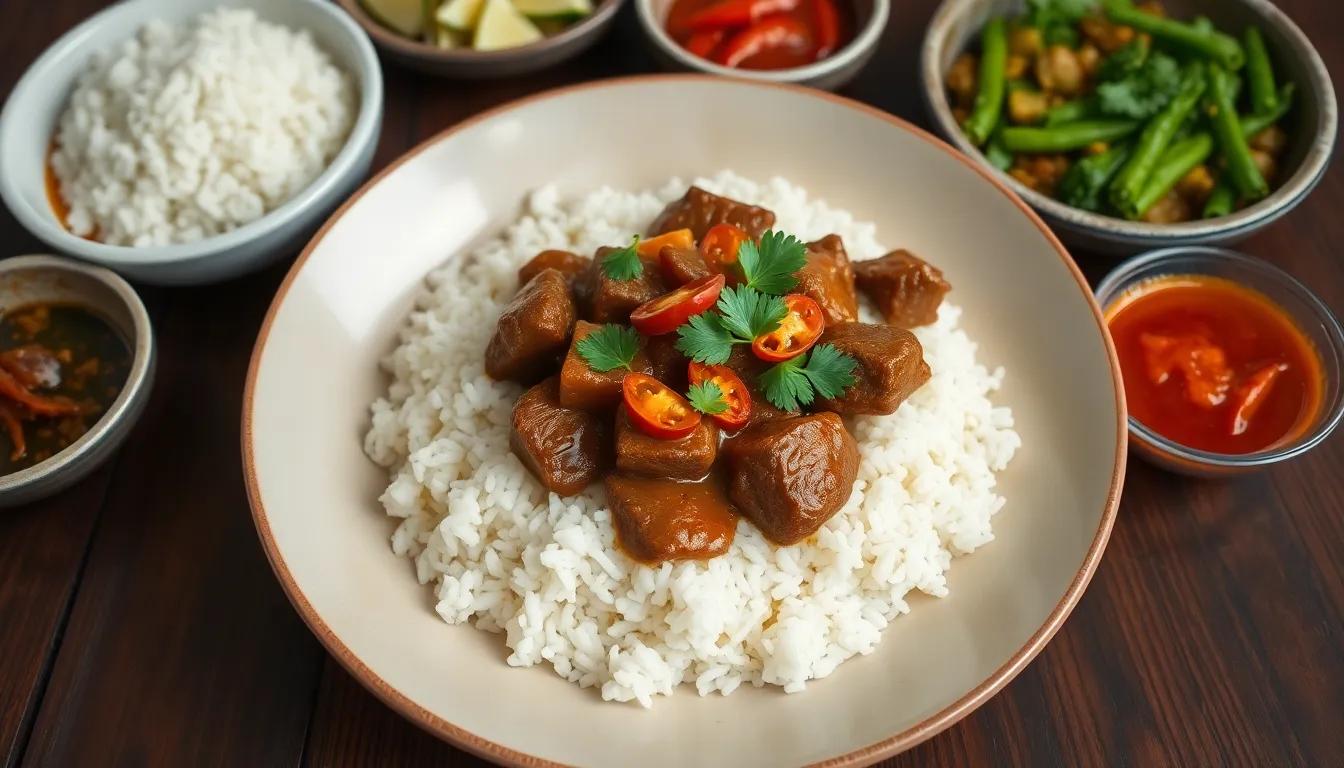
Our perfectly cooked beef rendang deserves thoughtful presentation to showcase its rich complexity. We recommend serving this aromatic dish with steamed white rice as the traditional foundation that allows the bold flavors to shine through each bite.
Traditional Rice Pairings
| Rice Type | Flavor Profile | Best For |
|---|---|---|
| Steamed white rice | Neutral, mild | First-time rendang experience |
| Coconut rice (nasi lemak) | Creamy, fragrant | Authentic Malaysian presentation |
| Jasmine rice | Aromatic, slightly sweet | Enhanced flavor pairing |
Fragrant coconut rice elevates our rendang to restaurant-quality presentation while complementing the dish’s creamy coconut base. The subtle sweetness of coconut rice balances the intense spices beautifully.
Essential Side Dishes
We always serve our beef rendang alongside traditional Malaysian accompaniments that enhance the overall dining experience. Acar (pickled vegetables) provides a refreshing contrast to the rich curry with its tangy crunch cutting through the deep flavors.
Sambal adds an extra layer of heat for those who appreciate bold spice levels. Simple boiled greens like kangkung or choy sum offer a mild vegetable component that cleanses the palate between bites.
Festive Presentation Ideas
Our beef rendang shines as the centerpiece of special occasions and festive meals throughout Malaysia. We arrange the tender beef in shallow serving bowls to display the glossy dark sauce that clings to each piece.
Garnish with fresh herbs like cilantro or sliced red chilies for color contrast. Serve family-style with multiple rice options and various sambals to create an authentic Malaysian feast that celebrates this beloved dish.
The beauty of our rendang lies in its ability to taste even better the next day as flavors continue developing. We often prepare larger batches for gatherings knowing that guests will request seconds and thirds of this irresistible Malaysian treasure.
Conclusion
We’ve shared everything you need to master this iconic Malaysian dish from start to finish. With our detailed guide you’ll create tender beef that’s perfectly infused with aromatic spices and rich coconut flavors.
The beauty of beef rendang lies in its patience-rewarding cooking process. While it takes time to develop those complex flavors your efforts will be rewarded with a restaurant-quality dish that’s even better the next day.
Now you’re ready to bring the authentic taste of Malaysia to your kitchen. Gather your ingredients fire up that stove and prepare to impress your family and friends with this legendary Southeast Asian masterpiece.
Frequently Asked Questions
What is Malaysian beef rendang?
Malaysian beef rendang is a beloved Southeast Asian dish featuring tender beef slow-cooked in coconut milk with aromatic spices. Originating from the Minangkabau people of West Sumatra, this rich curry transforms tough beef cuts into melt-in-your-mouth perfection through traditional cooking techniques. The dish balances sweet, spicy, and savory flavors, making it one of Malaysia’s most celebrated culinary treasures.
What equipment do I need to make authentic beef rendang?
Essential equipment includes a heavy-bottomed pot or Dutch oven for even heat distribution, a food processor or high-powered blender for the spice paste, and a wooden spoon or heat-resistant spatula. You’ll also need a fine-mesh strainer, sharp chef’s knife, cutting board, and measuring cups and spoons to achieve restaurant-quality results at home.
What are the main ingredients for beef rendang spice paste?
The spice paste requires shallots, garlic, galangal, ginger, lemongrass, dried red chilies, ground turmeric, and ground coriander. These aromatics are blended together to create the flavor base that gives rendang its distinctive taste. Soaking the dried chilies beforehand ensures a smooth, well-integrated paste that forms the foundation of this complex dish.
How long does it take to cook beef rendang properly?
Beef rendang requires slow cooking on low heat for several hours to achieve tender, flavorful results. The process involves initial browning, followed by long simmering in coconut milk until the beef absorbs the complex flavors. The final reduction stage creates the characteristic thick, dark sauce that clings to the meat, indicating the dish is ready.
What is kerisik and why is it important?
Kerisik is toasted grated coconut that adds unique aroma and texture to authentic beef rendang. This traditional ingredient provides nutty depth and helps thicken the sauce naturally. Mastering kerisik preparation is crucial for achieving restaurant-quality flavor, as it contributes to the dish’s distinctive taste profile that sets authentic rendang apart from simplified versions.
How should I store and reheat leftover beef rendang?
Cool rendang completely before storing in airtight containers. Refrigerated rendang stays fresh for up to 4 days, while frozen portions maintain quality for 2 months. Reheat gently on the stovetop or in the microwave, adding a splash of water if needed. Many find reheated rendang tastes even better as the spices continue to meld together.
What should I serve with beef rendang?
Beef rendang pairs perfectly with steamed white rice, coconut rice, or jasmine rice to balance the rich flavors. Traditional accompaniments include acar (pickled vegetables) and sambal for added contrast. Serve family-style with garnishes for an authentic Malaysian feast experience. The dish is ideal for gatherings and special occasions due to its impressive presentation.
Can beef rendang be made ahead of time?
Yes, beef rendang is excellent for meal prep and often tastes better the next day as flavors develop further. The slow-cooking process makes it perfect for advance preparation. Store properly in the refrigerator for up to 4 days or freeze in meal-sized portions. This makes it a popular choice for entertaining and busy weeknight dinners.

